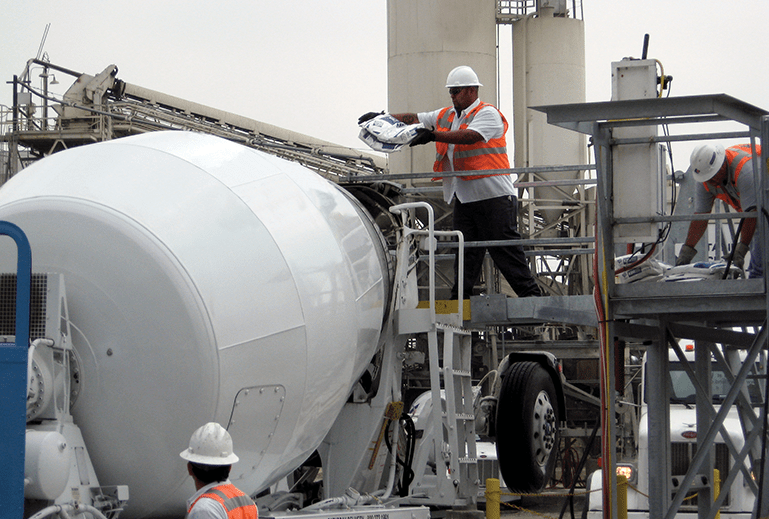
WATERLIGHT, SELF-SEALING CONCRETE STRUCTURES ARE RESILIENT FOR THE LONG TERM
By Kim Biggar
Driving concrete piles in the construction of a deep foundation makes them prone to cracking, which leads to water penetration and corrosion of the reinforcing steel. This is an issue that pile driving contractors have dealt with largely by applying an oil-based coating to the concrete piles before driving. The coating is intended to serve as a barrier to water penetration.
The problem with this solution, says Alireza Biparva, a concrete specialist at Kryton International Inc. in Vancouver, B.C., is that some of the protective coating is almost certainly damaged or stripped off the concrete during installation of the pile. Friction with the soil during driving can damage the membrane, reducing its effectiveness as a water barrier.
Once a concrete pile with uncoated areas is in direct contact with soil, chemicals such as sulphates can corrode the concrete, causing deterioration and weakening of the piles, potentially leading to settlement of the structure they support. Use of a sulphate-resistant cement can help with this issue, but it will not prevent water penetration.
Making concrete watertight
In 1973, Kryton International was launched with a new product for concrete waterproofing. The Krystol® product (Krystol T1) was originally created to be applied to the surface of concrete. Mixed with water, this powdered product is made into a slurry that is applied using a concrete brush. The slurry product is an effective solution both for the repair of existing structures and in new construction with precast piles. T1 not only acts as a physical barrier, it also penetrates the concrete to serve as chemical protection. Even if the coating or the surface of the concrete is damaged, the concrete remains protected because of the T1’s penetration into the concrete.
In the 1980s, Kryton invented Krystol Internal Membrane™ (KIM), a waterproofing admixture. KIM is added to the concrete as it is being made, rather than applied to hardened concrete. Biparva, the research and development manager for Kryton, describes this as an integral waterproofing system that makes the concrete itself a water barrier.
With both the surface-applied and the admixture solutions, the Krystol product’s – “magic crystals,” said Biparva – react with unhydrated cement particles, creating millions of insoluble needle-like crystals that spread deep into the concrete. The crystals continue to grow for months, sealing the concrete’s micro cracks and voids, effectively blocking pathways for water and waterborne contaminants. And, because the crystals grow deep into the concrete, the friction caused by pile driving cannot remove the product.
Benefits of Krystol use
The fact that Krystol is not removed or damaged during driving is the first among its benefits. That feature is essential; without it, the product’s other benefits might not remain.
Since this benefit is delivered by any admixture waterproofing solution, though, Biparva said “the key benefits of Krystol come back to its special ingredients. Krystol acts as a catalyst to a larger reaction within the concrete mass. Hence, it is not consumed. The chemical is never used up during the crystallization process.” As a catalyst, he says, only a very small amount of Krystol is required to grow a very large quantity of crystals. The ability to reactivate in the presence of water gives crystalline-treated concrete the ability to self-seal. The Krystol remains in the concrete structure for the entire life of the structure and can be reactivated at any time.
This long-term crystal-producing property enables the product to permanently waterproof concrete piles and protect their reinforcing steel. The durability this results in increases the service life of the structure, certainly a selling feature for contractors in their bids for jobs. (In other applications, use of Krystol means that fewer repairs are required over the years, which helps to keep long-term maintenance costs down.)
The admixture, simply added to the other components in the concrete-making process, saves a lot of time for waterproofing, thereby lowering labour costs for this part of any project.
“We sell a lot of the product based on the cost and time savings it enables,” said Kris Till, product manager for Kryton.
Further, according to Biparva, the product is environmentally friendly. Not oil based and with no volatile organic compounds, the crystals become part of the concrete. Concrete piles treated with Krystol that are part of a structure at the end of its service life can be recycled into aggregate without concern for their environmental impact; the product is safe for contact with potable water and certified by NSF International to NSF/ANSI Standard 61 Drinking Water System Components – Health Effects. It also has no effect on air quality.
Till notes that Krystol has been used in 55 countries around the world. Those countries include Canada and Qatar, demonstrating the product works effectively at both very low and very high temperatures.
Utilizing concrete waterproofing products in the piling industry
Construction RFQs and RFPs don’t frequently stipulate the use of a Krystol product for concrete piles. Biparva believes that reflects a still-limited awareness of the product (and its benefits) for this purpose.
Krystol distributors – many local ready-mix producers – can provide cost information to enable pile driving companies to plan for the use of Krystol in their project proposals. The Kryton website also features a cost-comparison calculator to allow contractors to determine the upfront cost of the product for their application. Till says the product cost is comparable to or lower than that of other waterproofing options.
The long service life for concrete piles treated with Krystol boosts the product’s value. Any cost comparison should take that value into account. Watertight and durable concrete piles will last well into the future.
